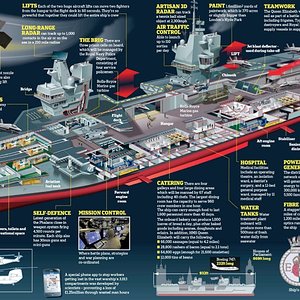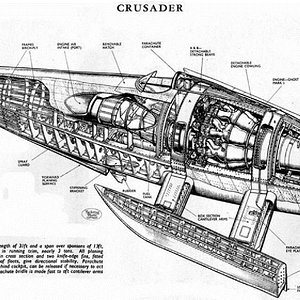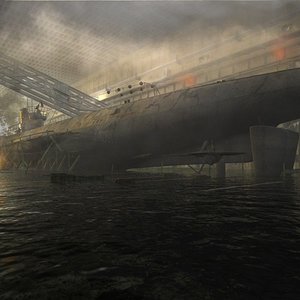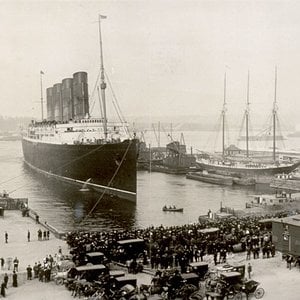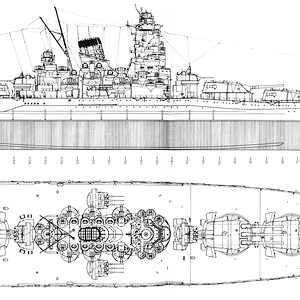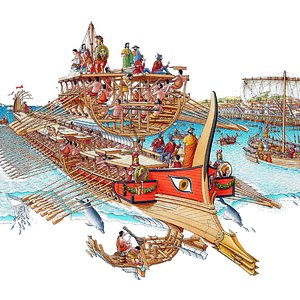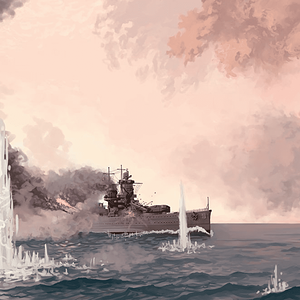Navigation
Install the app
How to install the app on iOS
Follow along with the video below to see how to install our site as a web app on your home screen.
Note: This feature may not be available in some browsers.
More options
You are using an out of date browser. It may not display this or other websites correctly.
You should upgrade or use an alternative browser.
You should upgrade or use an alternative browser.
Design[edit source | editbeta]
Lusitania unloading Christmas mail to a post office boat.
Cunard established a committee to decide upon the design for the new ships, of which James Bain, Cunard's Marine Superintendent was the chairman. Other members included Rear Admiral H. J. Oram, who had been involved in designs for turbine powered ships for the navy, and Charles Parsons, whose company Parsons Marine was now producing revolutionary turbine engines. Parsons maintained that he could design engines capable of maintaining a speed of 25 knots, which would require 68,000 horse power. The largest turbine sets built thus far had been of 23,000 bhp for the Dreadnought class battleships, and 41,000 bhp for Invincible class battlecruisers, which meant the engines would be of a new, untested design. Turbines offered the advantages of generating less vibration and greater reliability in operation at high speeds, combined with lower fuel consumption. It was agreed that a trial would be made by fitting turbines to Carmania, which was already under construction. The result was a ship 1.5 knots faster than her conventionally powered sister Caronia with the expected improvements in passenger comfort and operating economy.[6]
The ship was designed by Leonard Peskett[7] and built by John Brown and Company of Clydebank, Scotland. Peskett had built a large model of the proposed ship in 1902 showing a three funnel design. A fourth funnel was implemented into the design in 1904 as it was necessary to vent the exhaust from additional boilers fitted after steam turbines had been settled on as the powerplant. The original plan called for three propellers, but this was altered to four because it was felt the necessary power could not be transmitted through just three. Four turbines would drive four separate propellers, with additional reversing turbines to drive the two inboard shafts only. To improve efficiency, the two inboard propellers rotated inwards, while those outboard rotated outwards. The outboard turbines operated at high pressure; the exhaust steam then passing to those inboard at relatively low pressure. The propellers were driven directly by the turbines, since sufficiently robust gearboxes had not yet been developed, and only became available in 1916. Instead, the turbines had to be designed to run at a much lower speed than those normally accepted as being optimum. Thus, the efficiency of the turbines installed was less at low speeds than a conventional reciprocating steam engine, but significantly better when the engines were run at high speed, as was usually the case for an express liner. The ship was fitted with 23 double ended, and two single ended boilers (which fitted the forward space where the ship narrowed), operating at a maximum 195 psi and containing no fewer than 192 individual furnaces.[8]
Deck plans of Lusitania. Modifications were made both during, and after the ship's construction. By 1915 the Lifeboat arrangement had been changed to 11 fixed boats either side, plus collapsible boats stored under each lifeboat and on the poop deck.
Work to refine the hull shape was conducted in the Admiralty experimental tank at Haslar, Gosport. As a result of experiments, the beam of the ship was increased by 10 feet (3.0 m) over that initially intended to improve stability. The hull immediately in front of the rudder and the balanced rudder itself, followed naval design practice to improve the vessel's turning response. The Admiralty contract required that all machinery be below the waterline, where it was considered to be better protected from gunfire, and the aft third of the ship below water was used to house the turbines, the steering motors and four 375 kW steam driven turbo-generators. The central half contained four boiler rooms, with the remaining space at the forward end of the ship being reserved for cargo and other storage. Coal bunkers were placed along the length of the ship outboard of the boiler rooms, with a large transverse bunker immediately in front of that most forward (number 1) boiler room. Apart from convenience ready for use, the coal was considered to provide added protection for the central spaces against attack. At the very front were the chain lockers for the huge anchor chains and ballast tanks to adjust the ship's trim. The hull space was divided into twelve watertight compartments, any two of which could be flooded without risk of the ship sinking, connected by 35 hydraulically operated watertight doors. A critical flaw in the arrangement of the watertight compartments, was that sliding doors to the coal bunkers needed to be open to provide a constant feed of coal whilst the ship was operating, and closing these in emergency conditions could be problematic. The ship had a double bottom, with the space between divided into separate watertight cells. The ship's exceptional height was due to the six decks of passenger accommodation above the waterline, compared to the customary four decks in existing liners.[9]
High tensile steel was used for the ship's plating, as opposed to the more conventional mild steel. This allowed a reduction in plate thickness, reducing weight but still providing 26% greater strength than otherwise. Plates were held together by triple rows of rivets. The ship was heated and cooled throughout by a thermo-tank ventilation system, which used steam driven heat exchangers to warm air to a steady 65 °F (18.3 °C), while steam was injected into the airflow to maintain steady humidity. Forty-nine separate units driven by electric fans provided seven complete changes of air per hour throughout the ship, through an interconnected system, so that individual units could be switched off for maintenance. A separate system of exhaust fans removed air from galleys and bathrooms. As built, the ship conformed fully with Board of Trade safety regulations, which required sixteen lifeboats, with a capacity of approximately 1000 people.[10]
At the time of her completion Lusitania was briefly the largest ship ever built, but was eclipsed in this respect by the slightly larger Mauretania, which entered service shortly thereafter. She was 70 feet (21 m) longer, a full two knots faster, and had a capacity of 10,000 gross tons over and above that of the most modern German liner, Kronprinzessin Cecilie. Passenger accommodation was 50% larger than any of her competitors, providing for 552 saloon class, 460 cabin class and 1,186 in third class. Her crew comprised 69 on deck, 369 operating engines and boilers and 389 to attend to passengers. Both she and Mauretania had a wireless telegraph, electric lighting, electric lifts, sumptuous interiors and an early form of air-conditioning (described previously
Lusitania unloading Christmas mail to a post office boat.
Cunard established a committee to decide upon the design for the new ships, of which James Bain, Cunard's Marine Superintendent was the chairman. Other members included Rear Admiral H. J. Oram, who had been involved in designs for turbine powered ships for the navy, and Charles Parsons, whose company Parsons Marine was now producing revolutionary turbine engines. Parsons maintained that he could design engines capable of maintaining a speed of 25 knots, which would require 68,000 horse power. The largest turbine sets built thus far had been of 23,000 bhp for the Dreadnought class battleships, and 41,000 bhp for Invincible class battlecruisers, which meant the engines would be of a new, untested design. Turbines offered the advantages of generating less vibration and greater reliability in operation at high speeds, combined with lower fuel consumption. It was agreed that a trial would be made by fitting turbines to Carmania, which was already under construction. The result was a ship 1.5 knots faster than her conventionally powered sister Caronia with the expected improvements in passenger comfort and operating economy.[6]
The ship was designed by Leonard Peskett[7] and built by John Brown and Company of Clydebank, Scotland. Peskett had built a large model of the proposed ship in 1902 showing a three funnel design. A fourth funnel was implemented into the design in 1904 as it was necessary to vent the exhaust from additional boilers fitted after steam turbines had been settled on as the powerplant. The original plan called for three propellers, but this was altered to four because it was felt the necessary power could not be transmitted through just three. Four turbines would drive four separate propellers, with additional reversing turbines to drive the two inboard shafts only. To improve efficiency, the two inboard propellers rotated inwards, while those outboard rotated outwards. The outboard turbines operated at high pressure; the exhaust steam then passing to those inboard at relatively low pressure. The propellers were driven directly by the turbines, since sufficiently robust gearboxes had not yet been developed, and only became available in 1916. Instead, the turbines had to be designed to run at a much lower speed than those normally accepted as being optimum. Thus, the efficiency of the turbines installed was less at low speeds than a conventional reciprocating steam engine, but significantly better when the engines were run at high speed, as was usually the case for an express liner. The ship was fitted with 23 double ended, and two single ended boilers (which fitted the forward space where the ship narrowed), operating at a maximum 195 psi and containing no fewer than 192 individual furnaces.[8]
Deck plans of Lusitania. Modifications were made both during, and after the ship's construction. By 1915 the Lifeboat arrangement had been changed to 11 fixed boats either side, plus collapsible boats stored under each lifeboat and on the poop deck.
Work to refine the hull shape was conducted in the Admiralty experimental tank at Haslar, Gosport. As a result of experiments, the beam of the ship was increased by 10 feet (3.0 m) over that initially intended to improve stability. The hull immediately in front of the rudder and the balanced rudder itself, followed naval design practice to improve the vessel's turning response. The Admiralty contract required that all machinery be below the waterline, where it was considered to be better protected from gunfire, and the aft third of the ship below water was used to house the turbines, the steering motors and four 375 kW steam driven turbo-generators. The central half contained four boiler rooms, with the remaining space at the forward end of the ship being reserved for cargo and other storage. Coal bunkers were placed along the length of the ship outboard of the boiler rooms, with a large transverse bunker immediately in front of that most forward (number 1) boiler room. Apart from convenience ready for use, the coal was considered to provide added protection for the central spaces against attack. At the very front were the chain lockers for the huge anchor chains and ballast tanks to adjust the ship's trim. The hull space was divided into twelve watertight compartments, any two of which could be flooded without risk of the ship sinking, connected by 35 hydraulically operated watertight doors. A critical flaw in the arrangement of the watertight compartments, was that sliding doors to the coal bunkers needed to be open to provide a constant feed of coal whilst the ship was operating, and closing these in emergency conditions could be problematic. The ship had a double bottom, with the space between divided into separate watertight cells. The ship's exceptional height was due to the six decks of passenger accommodation above the waterline, compared to the customary four decks in existing liners.[9]
High tensile steel was used for the ship's plating, as opposed to the more conventional mild steel. This allowed a reduction in plate thickness, reducing weight but still providing 26% greater strength than otherwise. Plates were held together by triple rows of rivets. The ship was heated and cooled throughout by a thermo-tank ventilation system, which used steam driven heat exchangers to warm air to a steady 65 °F (18.3 °C), while steam was injected into the airflow to maintain steady humidity. Forty-nine separate units driven by electric fans provided seven complete changes of air per hour throughout the ship, through an interconnected system, so that individual units could be switched off for maintenance. A separate system of exhaust fans removed air from galleys and bathrooms. As built, the ship conformed fully with Board of Trade safety regulations, which required sixteen lifeboats, with a capacity of approximately 1000 people.[10]
At the time of her completion Lusitania was briefly the largest ship ever built, but was eclipsed in this respect by the slightly larger Mauretania, which entered service shortly thereafter. She was 70 feet (21 m) longer, a full two knots faster, and had a capacity of 10,000 gross tons over and above that of the most modern German liner, Kronprinzessin Cecilie. Passenger accommodation was 50% larger than any of her competitors, providing for 552 saloon class, 460 cabin class and 1,186 in third class. Her crew comprised 69 on deck, 369 operating engines and boilers and 389 to attend to passengers. Both she and Mauretania had a wireless telegraph, electric lighting, electric lifts, sumptuous interiors and an early form of air-conditioning (described previously


